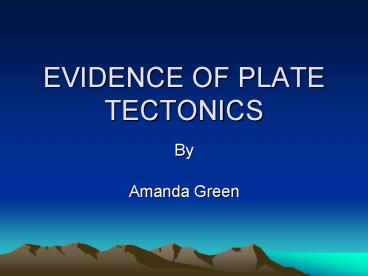EVIDENCE OF PLATE TECTONICS - PowerPoint PPT Presentation
1 / 15
Title:
EVIDENCE OF PLATE TECTONICS
Description:
New lithosphere produced. Older lithosphere consumed. Stress ... Lithosphere and asthenosphere. Lithosphere subducted. Occur primarily on plate boundaries ... – PowerPoint PPT presentation
Number of Views:256
Avg rating:3.0/5.0
Title: EVIDENCE OF PLATE TECTONICS
1
EVIDENCE OF PLATE TECTONICS
- By
- Amanda Green
2
Plate Tectonics
- Hypothesis
- Large rigid plates interacting
- Seismic belts
- Pangaea
- Earthquakes, Mountains, and Volcanoes
3
Pangaea
- Supercontinent
- Continental drift and sea-floor spreading
- Seven continents
- Fit
- Fossils
4
Pangaea 200 Ma and Now
Figure 1. (A) Pangaea at 200 Ma and (B) present
position of continents (Keller and Pinter, 1996,
Fig 1.4).
5
South America and Africa
Figure2. Bullard et al.s (1965) fit of South
America to Africa (Le Pichon and Others, 1973,
Fig. 8).
6
Seismic Activity
- Base Level and Erosion
- Earth is not static
- Continuous elevation
- Seismic activity
- New lithosphere produced
- Older lithosphere consumed
7
Stress
- Stress produced
- Stress exceeds the strength of rock
- Rock ruptures
- Energy is released
8
Global Seismic Activity
Figure 3. Map of global seismic activity
(1963-1988, Richter magnitude M greater
than 5.0), delineating belts of earthquake
activity that define plate boundaries (Keller and
Pinter, 1996, Fig 1.5).
9
Plate Boundaries
Figure 4. Recent volcanoes, earthquake zones, and
plate boundaries (Keller and Pinter, 1996, Fig
1.2).
10
Volcanoes
- Consuming plate boundaries
- Lithosphere and asthenosphere
- Lithosphere subducted
- Occur primarily on plate boundaries
11
Plate Boundaries
Figure 4. Recent volcanoes, earthquake zones, and
plate boundaries (Keller and Pinter, 1996, Fig
1.2).
12
Mountain Building
- Individual and gradual uplift processes
- Convergence
- Partial melting
13
Mountains
- Himalayas collision of India with Asia millions
of years ago - Still colliding growing today
- Appalachian Mountain North America and Africa
collided in the Late Paleozoic, around 300 Ma.
14
Himalayas
Figure 5. Extrusion of eastern and southeastern
Asia caused by the India-Asia collision (Keller
and Pinter, 1996, Fig 9.7).
15
Conclusion
- Evidence
- Importance to society
- Importance to geology






























